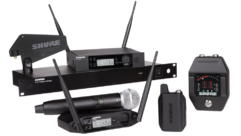Staying Consistent
Jul 1, 1998 12:00 PM,
Richard Buskin
Open since the first Sunday of May 1998, Woodlawn United Pentecostal,Columbia, MS, is a 1,100-seat church with enough floor space to accommodateup to 1,700 people courtesy of its wide aisles and altar areas. In additionto hosting services featuring electric instruments and a 100-voice choir,the establishment also stages dramatic productions that require asophisticated audio system.
“We have a good music program at this church, and that has been atremendous drawing card for us,” said Pastor James Carney. “We havemultiple talents here in the musical field, and that’s the reason we dodrama productions, too. We plan to do a lot of these productions, and so wejust felt like we needed a top-quality system to handle sound effects andthings of that nature.”
Sound contractor Prentice McNeil of MME Pro Audio in Lake Charles, LA,eventually saw X-Array as the answer, but this was only after a process ofelimination and discovery.
“From the get-go, the church authorities said they wanted the best soundthat money could buy,” he said. “They were looking not only for a concertsound, but also a theater sound, so I discussed what to put in there withmy partner and installer, Curt Taylor. He mentioned one system that Ididn’t think would give them the desired concert levels. Then he suggestedanother system, and I said that would be too hard to run. However, beingthat I didn’t have any other ideas as to what we could install, I told himthat if what this church needs doesn’t exist, then perhaps we could seekdivine inspiration.
“I called Electro-Voice and explained my dilemma. I told them what Iexpected the system to do, and they said that they had just developed a newproduct that sounded like it fit the bill, and that they hadn’t finishedtesting it yet.
“This was before anyone really knew much about this system, and when I readthe specifications, it just felt right. We met with the pastor and said,’Look, just bear with us. I think it would be a mistake to put anythingelse in here. Let’s just wait for this thing to develop.’ At that point Iwas going for X-Array or nothing, and fortunately the pastor trusted myjudgement.”
At Woodlawn the setup consisted of five full-range Xn cabinets in acenter-cluster configuration-three covering the floor area while the othertwo, which are flanked in between, cover the balcony-together with an Xnleft and Xn right to provide a true stereo sound. Dallas-based Joyner &Associates were the acoustic designers during construction of the building,and being that there are direct sight-lines both below and above thebalcony, coverage is very good.
“We initially looked at the plans and studied the room, and the coverage isreally uniform,” said McNeil. “We’ve even checked it out after the factwith a dB meter and pink noise, and it’s amazing how consistent the soundis throughout the auditorium. The first pew starts at least 20 feet (6 m)from the altar area at the front of the stage, and we initiallyconcentrated on covering the pews. Well, there was a complaint that thealtar area where they spend a great deal of time at the end of the servicewasn’t quite as bright as the sanctuary, so we just tilted the loudspeakersa little bit more. That way we didn’t lose any intelligibility in thehouse, but we were able to increase it in the altar area, and everyone waspleased. Other than that, everything went pretty much according to plan.”
While the on-stage monitor mix board is a DDA CS12M40 (catering to tenindividual monitor mixes powered with Electro-Voice amps), the mixingconsole is a 48-channel DDA CS8 with 12 additional stereo channels.Positioned at the front edge of the balcony, the board has been customizedso that the matrix, the sub-masters and all of the outputs are equippedwith a transformer to eliminate the possibility of ground loops attachingthemselves to the system.
“They needed about 60 inputs, and we had originally specified more than oneconsole,” explained McNeil. “However, the room really wasn’t available forthe extra space which that would take, and they also didn’t like theinaccessibility of having more than one console. We therefore spent sometime with DDA, and in customizing the board, we were able to change a lotof the mono channels to stereo, which we needed anyway, and so we were ableto double up. The board now has 16 stereo channels and 32 mono channels fora total of 64 inputs.”
Each input includes left-center-right panning, or what DDA calls spatialimaging. With the stage at Woodlawn United Pentecostal Church measuring 100feet (30.5 m) wide and 40 feet (12 m) deep, the pastor has plenty of roomto pace around as he delivers his sermon, and the sound of his voice can bepanned according to where he is at any given moment. Nevertheless, the mainadvantage of the left-center-right setup still relates to the requirementsof the drama productions, as well as to providing clear separation betweenthe music and the vocals.
“You get the best vocal intelligibility from a single source, and it worksso much better for preaching and vocals to have the sound coming from thecenter of the building instead of from the left or from the right,” saidMcNeil. “There’s no interference from the two sides, but effects and musicjust sound a little bit dry, and I would like to hear music better in astereo situation. With a left-center-right system, you can have your cakeand eat it too. You can experiment with stereo and single-point source atthe same time.”
With full congregations having already packed the auditorium, it had been acase of so far, so good with respect to the sound installation.Nevertheless, Pastor Carney felt that there is still some slight room forimprovement.
“We’ve got some live walls that we will probably try to dampen as time goeson,” he said. “There are high walls and there are sheet-rock walls, andthey have a tendency to give you a little bounce, so in the future weintend to do something about that. As a matter of fact, right now we arecovering the balcony wall with sound-board, and that has helped ustremendously.
“At our previous church here we had a good sound system, but it wasn’t thissophisticated. Every church service involves sound, and if you’ve got goodsound, you’ve got a good service. Likewise, bad sound means a bad service.Many people don’t realize how important the sound is.”
“Right now, until the sound people are totally comfortable with the setup,they’re basically just trying to achieve a balance throughout the house,”added McNeil. “However, they’ve got unlimited tools to do whatever theywant to do, and when they’re comfortable with the system, they’ll startexperimenting. There’ll be a drama presentation or a concert here in thenear future, and then we’ll really be able to hear what the system can do.”
Indeed, given the fact that the sound engineers at Woodlawn UnitedPentecostal are church volunteers, X-Array’s ring mode decoupling providesa distinct advantage. Thanks to the system, the content in the mid-range isextremely clear. There’s good definition between instruments and vocals,and the dynamic integrity amounts to the loudspeakers sounding the same athigh levels as they do at low volume, so it takes little effort to maintaina consistent level of audio quality.
“The budget was there to get a state-of-the-art system on this job,” saidMcNeil. “On other jobs we’ve seen that without equipment of this nature itsounds good when you’re there installing and running it, but whenever thesound personnel have limited ability, they’re just not going to be able todo the job when you’re gone. At Woodlawn, on the other hand, it soundsabsolutely wonderful, and I’ve never heard a bad service there. We don’trun the sound; we just sit there and enjoy it and let them handle it.
“There’s a whole lot to the ring mode decoupling. They’ve used this systemfor a wedding, and they’ve used it for full-blown concert sound on Sundaynights. It remains consistent at any volume. On any other system, I thinkthe problem is in the mid-range-it’s either piercing or muffled, and itconstantly changes according to the volume. With this system, the mid-rangeis so good that you could listen to it by itself and it would still soundwonderful. That’s what separates it from the rest.”
What has made the X-Array the system of choice for not only The RollingStones , but also for an smaller and plusher venue in rural Mississippi?For one thing, the high array density is achieved courtesy of the setup’srelatively small and lightweight dimensions, with the cabinets being riggedclosely together thanks to rigging points placed on the front and backinstead of top/bottom or sides. Then, to enhance the line array capability,there’s the coaxial nature of the high-frequency devices.
To best understand what is going on, we must first look at the kind ofobstacles that usually require tackling. Whenever medium- or high-Q systemsare employed, the HF horns comprise resonant tubes with a non-harmonicstructure, something that becomes more problematic as an increasing numberof individual enclosures are added to the array. The fundamental resonantmode of the HF horn is not in the band of the HF driver, but it does existin the band of the mid-bass, where all of the vocals lie. When a systemincludes an HF device that is mounted non-coaxially, it is acceptable tolisten to a single or double grouping of enclosures; there is slightringing but nothing substantial. When, on the other hand, this same HFdevice is placed coaxially, the ringing is significantly worse on a singleor double system because the mid bass wave completely surrounds thehigh-frequency device, stimulating the ringing modes that exist in the HFhorn. Consequently, when large arrays are employed, the ringing modesbecome even more pronounced in coaxial systems, while staying the same innon-coaxial ones.
X-Array’s solution is ring mode decoupling. When a front-of-house engineerfinds that a system does not respond fully to EQ, this is because the ratioof resonant ringing to signal remains fixed. If he cuts the ringing mode,then he also cuts the signal information in that band, and so by decouplingthe ringing modes that exist between the high frequency and mid-basssections, the X-Array system minimizes the high-frequency horns’fundamental resonance mode.










